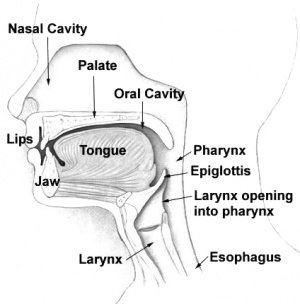Upper Respiratory Airways
Introduction[edit | edit source]
The respiratory system is structurally divided into the upper and lower respiratory system. The upper airways are the nose, nasal cavity, and pharynx while the lower airways are the larynx; trachea, bronchial tree and the lungs.
The Nose[edit | edit source]
The nose has an external portion and an internal portion inside the skull. It is formed by an upper framework of bone (made up of the nasal bones, the nasal part of the frontal bones and the frontal processes of the maxillae), a series of cartilages in the lower part, and a small zone of fibro-fatty tissue that forms the lateral margin of the nostril (the ala).
The nasal septum is usually straight at birth and it remains straight through out early childhood, but as a person ages, the septum bends toward one side. This may cause obstruction of the nasal cavity making breathing difficult. The interior part superior and posterior to the nose consist of the nasal cavity.
The nasal cavity[edit | edit source]
The nasal cavity extends from the nostrils to the choanae which are the openings into the pharynx. The anterior part of the nasal cavity inside each nostrils, contains the vestibule which is a dilated chamber and it is lined with coarse hairs or vibrissae and stratified squamous epithelium which is continuous with the stratified squamous epithelium of the skin. The nasal septum composed of bone and cartilage divides the nasal cavity into right and left chambers called nasal fossae. The lateral wall of the fossa gives rise to three folds of tissues: the superior, middle, and inferior nasal conchae.







